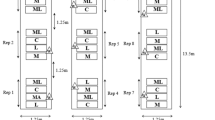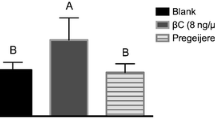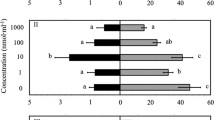Abstract
Herbivore-induced plant volatiles (HIPVs) play an important role in tritrophic interactions, and have the potential to attract beneficial arthropods into crops to enhance biological control of target pests. We conducted field trials in citrus and grapes to evaluate the response of abundant insect species to two HIPVs, methyl salicylate (MeSa) and (Z)-3-hexenyl acetate. Micromus tasmaniae (Hemerobiidae) showed significant attraction to MeSa, but only in the vineyard trial. Parastethorus nigripes (Coccinellidae) was also attracted to MeSa in the vineyard, but in the second citrus trial the treatment response was just outside the nominal 5% significance level. In the first citrus trial where P. nigripes was not separated taxonomically from the closely related coccinellid Stethorus vagans, a combined analysis was undertaken and significant attraction of both coccinellid species to MeSa was also observed. There was also a significant positive combined response of P. nigripes and S. vagans to (Z)-3-hexenyl acetate in the first citrus trial. Other predatory insect species did not respond to MeSa or (Z)-3-hexenyl acetate. As compared with the vineyard trial, weaker attraction of some insect species in the citrus trials may reflect high levels of background odour in the citrus orchard that could have interfered with normal insect olfactory responses. Our results support previous studies demonstrating coccinellids in the tribe Stethorini are often strongly attracted to MeSa. Deploying MeSa dispensers in vulnerable crops could attract increased numbers of P. nigripes, enhancing the biological control of pest tetranychid mites in Australian horticultural systems and reducing or eliminating the need for miticide applications.

Similar content being viewed by others
References
Agelopoulos, N., Birkett, M. A., Hick, A. J., Hooper, A. M., Pickett, J. A., Pow, E. M., Smart, L. E., Smiley, D. W. M., Wadhams, L. J., & Woodcock, C. M. (1999). Exploiting semiochemicals in insect control. Pesticide Science, 55, 225–235.
Azeem, M., Rajarao, G. K., Terenius, O., Nordlander, G., Nordenhem, H., Nagahama, K., Norin, E., & Borg-Karlson, A. K. (2015). A fungal metabolite masks the host plant odor for the pine weevil (Hylobius abietis). Fungal Ecology, 13, 103–111.
Bianchi, F. J. J. A., Schellhorn, N. A., & Cunningham, S. A. (2013). Habitat functionality for the ecosystem service of pest control: reproduction and feeding sites of pest and natural enemies. Agricultural and Forest Entomology, 15, 12–23.
Biddinger, D. J., Weber, D. C., & Hull, L. A. (2009). Coccinellidae as predators of mites: Stethorini in biological control. Biological Control, 51, 268–283.
Bruce, T. J. A., Martin, J. L., Pickett, J. A., Pye, B. J., Smart, L. E., & Wadhams, L. J. (2003). cis-jasmone treatment induces resistance in wheat plants against the grain aphid, Sitobion avenae (Fabricius) (Homoptera: Aphididae). Pest Management Science, 59, 1031–1036.
Butler, D., Cullis, B. R., Gilmour, A. R., & Gogel, B. J. (2009). Analysis of mixed models for S language environments. ASReml-R reference manual. Queensland Department of Primary Industries and Fisheries, Brisbane / NSW Department of Primary Industries, Orange.
Colless, D. H. (1982). Australian Anthomyiidae (Diptera). Australian Journal of Zoology, 30, 81–91.
Colless, D. H., & McAlpine, D. K. (1991). Diptera (Flies). in: The Insects of Australia. A Textbook for Students and Research Workers (Vol. 2, 2nd ed.pp. 717–786). Melbourne: CSIRO / Melbourne University Press.
Diatloff, A. (1965). Larvae of Rivellia sp. (Diptera : Platystomatidae) attacking the root nodules of Glycine javanica L. Journal of the Entomological Society of Queensland, 4, 86.
Dudareva, N., & Negre, F. (2005). Practical applications of research into the regulation of plant volatile emission. Current Opinion in Plant Biology, 8, 113–118.
Field, R. P. (1979). Integrated pest control in Victorian peach orchards: the role of Stethorus spp. (Coleoptera: Coccinellidae). Journal of the Australian Entomological Society, 18, 315–322.
Flint, H. M., Salter, S. S., & Walters, S. (1979). Caryophyllene: an attractant for the green lacewing. Environmental Entomology, 8, 1123–1125.
Gadino, A. N., Walton, V. M., & Lee, J. C. (2012). Evaluation of methyl salicylate lures on populations of Typhlodromus pyri (Acari: Phytoseiidae) and other natural enemies in western Oregon vineyards. Biological Control, 63, 48–55.
Gencer, N. S., Kumral, N. A., Sivritepe, H. O., Seidi, M., Susurluk, H., & Senturk, B. (2009). Olfactory response of the ladybird beetle Stethorus gilvifrons to two preys and herbivore-induced plant volatiles. Phytoparasitica, 37, 217–224.
Gouinguene, S. P., & Turlings, T. C. J. (2002). The effects of abiotic factors on induced volatile emissions in corn plants. Plant Physiology, 129, 1296–1307.
Harper, D. B., Hamilton, J. T. G., Kennedy, J. T., & McNally, K. J. (1989). Chloromethane, a novel methyl donor for biosynthesis of esters and anisoles in Phellinus pomaceus. Applied and Environmental Microbiology, 55, 1981–1989.
Heil, M. (2004). Induction of two indirect defences benefits lima bean (Phaseolus lunatus, Fabaceae) in nature. Journal of Ecology, 92, 527–536.
van Herk, W. G., Vernon, R. S., Cronin, E. M. L., & Gaimari, S. D. (2015). Predation of Thereva nobilitata (Fabricius) (Diptera: Therevidae) on Agriotes obscurus L. (Coleoptera: Elateridae). Journal of Applied Entomology, 139, 154–157.
Hunter, M. D. (2002). A breath of fresh air: beyond laboratory studies of plant volatile – natural enemy interactions. Agricultural and Forest Entomology, 4, 81–86.
James, D. G. (2003a). Field evaluation of herbivore-induced plant volatiles as attractants for beneficial insects: methyl salicylate and the green lacewing, Chrysopa nigricornis. Journal of Chemical Ecology, 29, 1601–1609.
James, D. G. (2003b). Synthetic herbivore-induced plant volatiles as field attractants for beneficial insects. Environmental Entomology, 32, 977–982.
James, D. G. (2005). Further field evaluation of synthetic herbivore-induced plant volatiles as attractant for beneficial insects. Journal of Chemical Ecology, 31, 481–495.
James, D. G., & Grasswitz, T. W. (2005). Synthetic herbivore-induced plant volatiles increase field captures of parasitic wasps. BioControl, 50, 871–880.
James, D. G., & Price, T. S. (2004). Field testing of methyl salicylate for recruitment and retention of beneficial insects in grapes and hops. Journal of Chemical Ecology, 30, 1613–1628.
Kanchiswamy, C. N., Malnoy, M., & Maffei, M. E. (2015). Chemical diversity of microbial volatiles and their potential for plant growth and productivity. Frontiers in Plant Science, 6, 151. https://doi.org/10.3389/fpls.2015.00151.
Kaplan, I. (2012). Trophic complexity and the adaptive value of damage-induced plant volatiles. PLoS Biology, 10, e1001437. https://doi.org/10.1371/journal.pbio.1001437.
Karl, T., Guenther, A., Turnipseed, A., Patton, E. G., & Jardines, K. (2008). Chemical sensing of plant stress at the ecosystem scale. Biogeosciences, 5, 1287–1294.
Kenward, M. G., & Roger, J. H. (1997). The precision of fixed effects estimates from restricted maximum likelihood. Biometrics, 53, 983–997.
Koethe, R. W., & Van Duyn, J. W. (1989). Soybean nodule fly, Rivellia quadrifasciata (Diptera: Platystomatidae): observations on adult food sources and responses to baits and traps. Journal of Agricultural Entomology, 6, 83–90.
Kost, C., & Heil, M. (2008). The defensive role of volatile emission and extrafloral nectar secretion for lima bean in nature. Journal of Chemical Ecology, 34, 2–13.
Lee, J. C. (2010). Effect of methyl salicylate-based lures on beneficial and pest arthropods in strawberry. Environmental Entomology, 39, 653–660.
Lentz, C., Petersen, G., Mölck, G., & Wyss, U. (2004). Olfactory orientation of the spider mite predator Stethorus punctillum. Mitteilungen der Deutschen Gesellschaft für Allgemeine und Angewandte Entomologie, 14, 191–194.
Maeda, T., Kishimoto, H., Wright, L. C., & James, D. G. (2015). Mixture of synthetic herbivore-induced plant volatiles attracts more Stethorus punctum picipes (Casey) (Coleoptera: Coccinellidae) than a single volatile. Journal of Insect Behaviour, 28, 126–137.
Michereff, M. F. F., Laumann, R. A., Borges, M., Michereff-Filho, M., Diniz, I. R., Neto, A. L. F., & Moraes, M. C. B. (2011). Volatiles mediating a plant-herbivore-natural enemy interaction in resistant and susceptible soybean cultivars. Journal of Chemical Ecology, 37, 273–285.
Paré, P. W., & Tumlinson, J. H. (1996). Plant volatile signals in response to herbivore feeding. Florida Entomologist, 79, 93–103.
Paré, P. W., & Tumlinson, J. H. (1999). Plant volatiles as a defence against insect herbivores. Plant Physiology, 121, 325–331.
R Development Core Team. (2016). R: A language and environment for statistical computing. Vienna: R Foundation for Statistical Computing. https://www.R-project.org/.
Rasgado, M. A., Malo, E. A., Crux-López, L., Rojas, J. C., & Toledo, J. (2009). Olfactory response of the Mexican fruit fly (Diptera: Tephritidae) to Citrus aurantium volatiles. Journal of Economic Entomology, 102, 585–594.
Rodriguez-Saona, C., Kaplan, I., Braasch, J., Chinnasamy, D., & Williams, L. (2011). Field responses of predaceous arthropods to methyl salicylate: a meta-analysis and case study in cranberries. Biological Control, 59, 294–303.
Sabelis, M., Janssen, A., Pallini, A., Venzon, M., Bruin, J., Drukker, B., & Scutareanu, P. (1999). Behavioural responses of predatory and herbivorous arthropods to induced plant volatiles: from evolutionary ecology to agricultural applications. In A. A. Agrawal, S. Tuzun, & E. Bent (Eds.), Induced plant defenses against pathogens and herbivores. Biochemistry, ecology and Agriculture (pp. 269–296). St Paul: APS Press.
Schröder, R., & Hilker, M. (2008). The relevance of background odor in resource location by insects: a behavioural approach. Bioscience, 58, 308–316.
Simpson, M., Gurr, G. M., Simmons, A. T., Wratten, S. D., James, D. G., Leeson, G., & Nicol, H. I. (2011). Insect attraction to synthetic herbivore-induced plant volatile-treated field crops. Agricultural and Forest Entomology, 13, 45–57.
Skuhravá, M., Martinex, M., & Roques, A. (2010). Diptera. Chapter 10. In Roques, A., Kenis, M., Lees, D., Lopez-Vaamonde, C., Rabitsch, W., Rasplus, J-Y., & Roy, D. (Eds.). Alien terrestrial arthropods of Europe. BioRisk 4, 553–602. https://doi.org/10.3897/biorisk.4.53.
Ślipiński, A. (2007). Australian ladybird beetles (Coleoptera: Coccinellidae). Their biology and classification. Australian Biological Resources Study: Canberra.
Soleyman-Nezhadiyan, E., & Laughlin, R. (1998). Voracity of larvae, rate of development in eggs, larvae and pupae, and flight seasons of adults of the hoverflies Melangyna viridiceps Macquart and Symosyrphus grandicornis Macquart (Diptera: Syrphidae). Australian Journal of Entomology, 37, 243–248.
Takabayashi, J., Dicke, M., & Posthumus, M. A. (1994). Volatile herbivore-induced terpenoids in plant-mite interactions: variation caused by biotic and abiotic factors. Journal of Chemical Ecology, 20, 1329–1354.
Takabayashi, J., Sabelis, M. W., Janssen, A., Shiojiri, K., & Van Wijk, M. (2006). Can plants betray the presence of multiple herbivore species to predators and parasitoids? The role of learning in phytochemical information networks. Ecological Research, 21, 3–8.
Takahashi, H., Takafuji, A., Takabayashi, J., Yano, S., & Shimoda, T. (2001). Seasonal occurrence of specialist and generalist insect predators of spider mites and their response to volatiles from spider-mite-infested plants in Japanese pear orchards. Experimental and Applied Acarology, 25, 393–402.
Thaler, J. S. (1999). Jasmonate-inducible plant defences cause increased parasitism of herbivores. Nature, 399, 686–688.
Tooker, J. F., Crumrin, A. L., & Hanks, L. M. (2005). Plant volatiles are behavioural cues for adult females of the gall wasp Antistrophus rufus. Chemoecology, 15, 85–88.
Turlings, T. C. J., Tumlinson, J. H., & Lewis, W. J. (1990). Exploitation of herbivore-induced plant odors by host-seeking parasitic wasps. Science, 250, 1251–1253.
Waelti, M. O., Muhlemann, J. K., Widmer, A., & Schiestl, F. P. (2008). Floral odour and reproductive isolation in two species of Silene. Journal of Evolutionary Biology, 21, 111–121.
Witzgall, P., Ansebo, L., Yang, Z., Angeli, G., Sauphanor, B., & Bengtsson, M. (2005). Plant volatiles affect oviposition by codling moths. Chemoecology, 15, 77–83.
Woods, J. L., James, D. G., Lee, J. C., & Gent, D. H. (2011). Evaluation of airborne methyl salicylate for improved conservation biological control of two-spotted spider mite and hop aphid in Oregon hop yards. Experimental and Applied Acarology, 55, 401–416.
Yu, H., Zhang, Y., Wu, K., Gao, X. W., & Guo, Y. Y. (2008). Field-testing of synthetic herbivore-induced plant volatiles as attractants for beneficial insects. Environmental Entomology, 37, 1410–1415.
Zhu, J., & Park, K.-C. (2005). Methyl salicylate, a soybean aphid-induced plant volatile attractive to the predator Coccinella septempunctata. Journal of Chemical Ecology, 31, 1733–1746.
Acknowledgments
The authors thank Robert Fiumara of Lillypilly Wines, Leeton for access to his vineyard. Peter Gillespie (NSW DPI), Dr. David Yeates and Dr. Adam Ślipiński (CSIRO Entomology) are thanked for providing assistance with insect identifications, and Dr. Shaun Winterton, California Department of Food and Agriculture, is thanked for providing information on the feeding biology of Therevidae. Glen Warren and Michelle Hallam provided invaluable assistance with the trapping program.
Author information
Authors and Affiliations
Corresponding author
Rights and permissions
About this article
Cite this article
Stevens, M.M., Faulder, R.J., Mo, J. et al. Attraction of Parastethorus nigripes and other insect species to methyl salicylate and (Z)-3-hexenyl acetate dispensers in a citrus grove and vineyard in south-eastern Australia. Phytoparasitica 45, 639–649 (2017). https://doi.org/10.1007/s12600-017-0619-5
Received:
Accepted:
Published:
Issue Date:
DOI: https://doi.org/10.1007/s12600-017-0619-5




